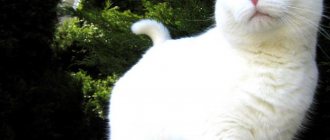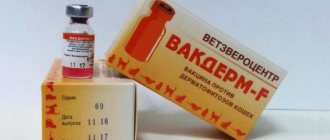Ringworm in cats is a fungal infection of an animal. What is the cause of the disease? In the first place is infection. Reduced immunity, allergies, and viruses are also prerequisites for the disease. More recently, 20 years ago, even 10 years ago, the disease was considered incurable. Pets were euthanized. Fortunately, today lichen in cats and kittens can be treated. The disease is contagious; it can infect other animals and, which is very unpleasant, people.
It is necessary to be vigilant and at the first signs of deprivation (we will talk about them a little later) not to self-medicate, but, having grabbed your pet, come to an appointment with a veterinarian for an accurate diagnosis. Many people encounter this for the first time, panic, search on forums, ask friends what to do? Yes, you can listen to advice, but! you should calm down and come with your cat to a doctor's consultation. By being patient and receiving the necessary treatment methods, you can help your pet recover.
In the article we will talk about the types of ringworm, its symptoms, and will dwell in more detail on the treatment of ringworm and prevention.
Types of lichen
There are several types of lichen. They differ not only in external signs, but are also treated differently.
- Lichen planus;
- Pink or herpes zoster;
- Ringworm or eczema;
- Pityriasis versicolor;
- Ringworm.
Lichen planus is characterized by the appearance of red blisters on the cat's skin. It itches constantly, the blisters burst, causing severe itching. Red bubbles appear in the groin, abdomen, and on the bends of the joints. The mucous membranes are affected. This type of lichen in a cat signals that not everything is ok with the immune system. The good news is that this shingles is not spread to other animals or people.
Pityriasis rosea in a cat is a sign of a viral infection. How does it manifest itself? Pink spots ranging in size from 1.5 to 2 cm appear on the animal’s body. The cat itches and the skin peels off. Then the stain becomes crusty. Ringworm usually goes away on its own. During the period of exacerbation, the animal should not be washed or released into the sun. You need to take care of his healthy diet. There is no consensus in the scientific world about whether pityriasis rosea in cats is dangerous or not.
With weeping lichen, red bubbles appear, filled with liquid, which are very painful. Ringworm or eczema is rare. The disease can be caused by a malfunction in the immune system, the presence of parasites, allergies to food and detergents. This type of lichen is not contagious.
Let's look at what pityriasis versicolor (varicolored) lichen in cats is. This type of lichen is very contagious for humans and is easily transmitted to other animals. It is also called “sun fungus” and “beach lichen”. Oval spots of pink, brown, pale yellow color appear on your pet's body, growing very quickly. Pityriasis versicolor requires long-term and serious treatment.
Possible limitations and negative phenomena
The drug is not applied to the area of the animal's mammary glands.
The pharmaceutical drug "Clotrimazole" is well tolerated and, when used correctly, has no side symptoms. A cat that has been found to be hypersensitive to the components of the drug is not suitable for antifungal medication. The annotation does not describe other restrictions, but if the owner has doubts about the safety of Clotrimazole for a pet, it is better to clarify the advisability of using this medication with a veterinarian. Do not apply the medicine directly to the skin of the mammary gland of a lactating female.
It is extremely rare that during the treatment of lichen and other infectious diseases, a cat may develop allergic reactions in the form of itching, redness and tingling of the treated areas of the dermis with the drug Clotrimazol. There is a decrease in the effectiveness of clotrimazole when used simultaneously with Nystatin. If hypersensitivity and irritation develop after using an antifungal pharmaceutical, you will need to stop treatment and choose another, most appropriate medication.
Ringworm
Now let’s take a closer look at what ringworm is in a cat. It is one of the most dangerous and common types of lichen. What is the danger and insidiousness of this disease? The fact is that the incubation period for lichen in cats can last from several days to several months. Other animals and unsuspecting people become infected. It is especially dangerous for long-haired breeds, since the hair prevents the first signs of the disease from being seen. How to treat ringworm in cats will be discussed a little later.
Let's consider what is the causative agent of ringworm? These are dermatophyte molds. There are two forms of ringworm:
- - microsporia;
- - trichyphytosis.
- What happens with microsporia?
- - hair fragility appears at the skin level;
- - wool hair is easily pulled out.
When hair falls out, other animals and people become infected with fungal spores.
Trichophytosis, the second form of the fungus, is very rare. With this type of ringworm, baldness appears only in the head and neck area.
There are three forms of the disease:
- -superficial;
- -deep;
- -atypical.
With a superficial and atypical form of ringworm in cats, for a long time it is impossible to notice that the disease process has already begun.
It is very important to identify the disease at an early stage; the method and time of treatment for your pet will depend on this.
Who is at risk and can get ringworm?
- -most often these are small kittens;
- - long-haired breeds (genetically predisposed to such diseases);
- - cats with malignant processes in the body;
- - cats infected with parasites;
- -young cats up to one year of age.
One of the most pressing and exciting questions is how is lichen transmitted from cats? Unfortunately, ringworm is contagious to humans. You love your pet, pet it, pick it up. Yes, usually upon contact the process of lichen infection occurs. This happens especially easily if there are scratches, wounds, or abrasions on your hands. You can become infected by dandruff, scales, and hair falling from a cat. Children can become infected very easily while playing in the sandbox. Your home, bowls, rugs, combs, etc. are contaminated. Fungal spores are very stable and viable. Will the person get sick or not? It depends on the type of lichen and the person’s immunity. Children and people with weakened immune systems are at risk.
Drug treatment
Ringworm can sometimes go away on its own if the cat has high body resistance. But this process is long, taking several months, and some types of it are dangerous for others. Therefore, it is better to consult a veterinarian who will explain how to cure lichen in a cat . The chosen means of therapy depend on the age of the pet, the size of the lesions, the state of immunity, and the severity of the disease:
- Vaccination. In modern veterinary medicine, the drugs Vakderm-F, Microderm, Polivac TM are used. Doctors' opinions about their benefits differ: some consider them effective, others doubt them. Vaccines are administered both for prophylaxis to healthy animals and during treatment - to exacerbate the disease and speed up recovery. The doctor calculates the dosage based on the cat’s weight. For prevention purposes, 2 injections are given, for treatment - 3, with a 10-day break between them. Before vaccination, deworming is mandatory.
- External means. Pharmacies offer a wide selection of topical medications: shampoos, creams, ointments, emulsions, solutions, drops, sprays. Many of them are also intended for people. Before treating lichen in a cat with these drugs, the hair around the lesions is carefully cut off. Long-haired animals are recommended to be completely shaved. Before using the product, put on a protective collar for the cat. The medicines are carefully applied to the infected areas with a cotton pad, lightly rubbing into the skin.
- Pills. Oral medications often have side effects, so they are prescribed only in severe cases when external remedies do not help for more than 2 to 4 weeks. The tablets are intended for humans, so only a veterinarian can calculate the dosage for cats. They are given in crushed form along with food or whole
In order for the cat to absorb the tablet, they take it by the withers - then the mouth will open. Then the medicine is inserted as deeply as possible and the mouth is kept closed until the animal makes a swallowing movement. After this, he can be released.
How to avoid getting shingles from a cat?
Firstly, do not have contact with stray animals and do not allow children to do this. After walking, be sure to wash your hands. If you have a cat, take it to the vet to have it checked for ringworm. Clean the apartment regularly using disinfectants. Be sure to treat your cat for parasites. It is important to provide your pet with a nutritious diet; this helps maintain its good condition, increases immunity, and therefore the skin’s resistance to infections.
Now let’s look at where cats get lichen from? Your pet can become infected through contact with a sick animal. And even without communicating with one, yours can become infected simply by walking in the country. Ringworm spores can be found on the soil. Sometimes you yourself are the cause of your absolutely domestic furry's illness. The fact is that you can bring fungus into your home on clothes, shoes, and things. Sometimes small children infect their pets. The child stroked a cute cat on the street and, when he came home, stroked his own. And that’s it, contact happened.
What can be observed with all types of lichen in cats:
- - hair falls out;
- - the skin becomes inflamed and peels;
- - areas of the skin become inflamed;
- - severe itching appears;
How to identify ringworm in a cat at home?
- -one of the first signs that should alert you is that the cat scratches itself often, eats poorly, and does not behave as usual. What happens, what should you pay attention to, how does lichen begin in cats?
- - round flaky spots appear. In some cases, spots appear all over the body. Ringworm often appears in cats on the ears, paws, and face. It all depends on the specific pathogen;
- - crusts form at the spots;
- - hair falls out;
- - your cat itches a lot, often chews and scratches spots;
- - scabs appear along the spine;
- -spots expand and take on an oval shape;
- - in places where the rash appears, the hair thins and the hairs become sparse;
- - the spots grow, if treatment is not started, your pupil will die.
Briefly about the atypical form of ringworm. The fact is that the signs of lichen described above in this form of the disease are absent or not clearly expressed. The disease proceeds unnoticed, since only individual hairs are affected. This is the danger of this disease. The owner does not suspect anything, since he does not see signs of infection, does not take any measures for a long time, and the disease develops.
Symptoms
Ringworm is one of the most dangerous types of fungal skin infections. Without treatment, it can lead to baldness and even death of the cat. At the initial stage, a rash appears on the skin. However, in long-haired cat breeds, the rashes are very difficult to notice. The early stages of lichen can also be determined by changes in the pet's behavior. The cat becomes anxious and restless, constantly itches and loses its appetite. As the fungus spreads, the animal's hair falls out and scales appear on the skin.
With pityriasis versicolor, brown, yellow or pink spots appear on the animal's skin. Most often they are localized on the paws, head or neck. These rashes are subtle and may periodically disappear and then reappear. Pityriasis versicolor is usually not accompanied by severe itching.
Pityriasis rosea most often appears in kittens or older animals. In cats, small pink spots appear on the skin, reminiscent of allergic rashes. These manifestations last about 6 - 9 weeks and then disappear. However, spots may reappear when immunity decreases.
What to do if you notice signs of lichen in your cat? Only a specialist can treat and identify such pathologies. After all, lichen is very easy to confuse with other types of skin diseases. You need to take your pet to the veterinarian as soon as possible. The doctor will examine the skin using a Wood's lamp. If you direct the light of the device to the affected area, a bluish or greenish glow appears when the lichen occurs. If necessary, scales are scraped from the area of the rash and sent for microscopic analysis.
How to determine if a cat has lichen or not?
If you suspect that something is wrong with your cat, do not delay visiting the veterinarian. This will save your time, nerves, and money on treatment. Skin diseases are mostly similar to each other. Even an experienced specialist will not be able to determine by eye what is wrong with your animal? To determine an accurate diagnosis, there are methods such as instrumental and laboratory tests. Using these methods, it is determined that your pet has allergic dermatitis or contagious ringworm.
Initially, the doctor examines your cat, interviews you, if there is a medical record, studies it. Then, after the examination, the examination begins.
- Your pet is scanned under a Wood's fluorescent lamp. Under a Wood's lamp, a cat's lichen glows green. This method is not accurate, because harmless microbes can glow and, conversely, pathogenic microbes do not glow.
- The next method is to scrape the skin or affected hair and examine it under a microscope. It's called trichoscopy. The result is also fast, but not one hundred percent. It is not always possible to detect a fungal infection, but this does not mean that the disease does not exist.
- Sowing a culture of a pathogenic fungus in a nutrient medium is the most accurate and reliable way to determine lichen. To do this, collect the crust and scales, which are placed in a Petri dish. After a certain time (you need to wait about three weeks to get the result), a diagnosis is made. This method is used if the disease has not been cured for a long time. The analysis helps you choose the right medications to cure your cat of lichen.
- Additionally, a blood test is taken. They examine whether your pet has chronic diseases and determine the presence of parasites.
You can undergo treatment in a clinic or at home. Most cats are treated by the owners themselves. How to treat lichen in a cat at home? Follow all the veterinarian's instructions; do not interrupt the course of treatment if you think that everything is already in order. Consult your doctor about what to feed your cat. Mandatory treatment of your home, this will be discussed further.
Medicines for animals > Zinc ointment 10%
Short description:
This drug is made on the basis of petroleum jelly with the addition of an active substance (zinc oxide). It is this component that ensures the action of the medicine. When applied externally, the ointment relieves inflammation, dries and disinfects the skin, and gives an astringent effect. Zinc ointment is a safe drug for animals.
We recommend reading: How to Clean a Dog’s Teeth from Tartar at Home Video
For whom:
It is used in all animals in the treatment of skin diseases that occur with the release of exudate and degeneration, accompanied by itching and (or) complicated by the addition of a bacterial infection.
Leave form:
the ointment is a homogeneous thick mass, the color of which may be white or slightly yellowish. The ointment has no smell. The zinc oxide content in it is 10%. For animals, manufacturers package it in plastic containers (jars) of 200 or 250 grams. The label affixed to the jar contains information about the manufacturer, the medicine itself and its composition, the release date and shelf life. The series number, technical conditions are also indicated there, and there are the inscriptions “External” and “For animals”.
Dosage:
Apply zinc ointment to the affected areas of the skin, spreading it in a thin layer, but not more than 2 times a day.
Restrictions:
The medicine is contraindicated in animals with known hypersensitivity to its components. The development of adverse reactions when using the ointment is rare. It is allowed to prescribe other drugs to animals along with this drug.
Dosage:
Apply zinc ointment to the affected areas of the skin, spreading it in a thin layer, but not more than 2 times a day.
How to remove lichen from a cat?
Treatment by a professional is the most correct and reliable method of treatment. There are also folk remedies. More on them later.
Treatment for ringworm in cats depends on the severity of the disease, the breed of the cat, its age, immunity, the presence of chronic diseases, and pregnancy. During treatment, different drugs are used. For local treatment - these are ointments, creams, sprays, drops, shampoos. For severe cases of the disease, tablets, vitamins and immunomodulators are prescribed. Vaccines are also used. Now let's look at some of the drugs used in treatment.
For example, Clotrimazole for lichen in cats. During the initial treatment of deprivation in a cat with Clotrimazole, the veterinarian gives her an injection and treats the infected areas with the drug. The product is available in the form of gels, solutions, creams, tablets, and injections. It is found on sale as Candizol, Amyclone and Fungin.
Veterinarians advise cat owners to have Clotrimazole ointment in their home medicine cabinet; they also use it for inflammatory processes. Scheme for treating ringworm in an animal with Clotrimazole ointment: lubricate the infected areas with ointment two to three times a day, applying a thin layer, gently rubbing. Do it within a week. Repeat after three to four weeks, lubricate once or twice a day. What to do if the areas are very large? First, wash the affected area with soap and water and dry. Then apply Clotrimazole ointment three to four times daily for three to four weeks.
Terbinafine, a broad-spectrum drug, is also used to treat ringworm in cats. Available in tablets, ointments, creams. Terbinafine ointment is applied in a thin layer to the infected areas once or twice a day. During healing, crusts form on the wounds, which must be removed with a cotton pad moistened with water.
The healing process can last 30 days or more. It all depends on the severity of the disease and the fungus. Very important: do not self-medicate! Anti-lichen tablets for cats are prescribed only by a specialist when the disease is severe, as they have side effects. The doctor prescribes the dosage and regimen of medications.
Now about the vaccine. Abroad (in Europe and America), the lichen vaccine is not used for cats. In Russia, the lichen vaccine for cats is used for both treatment and vaccination. The most common of them:
- Vakderm;
- -Microderm;
- -Polivak TM.
What does the shingles vaccination give? This is an opportunity to protect the animal from infection for a long time. The following must be taken into account:
- -Vaccination from the age of two months;
- -Contraindications – cat pregnancy;
- -The cat must be healthy. If she was sick, then the vaccine can be done after two or even three weeks;
- -10-14 days before the lichen vaccination, you must give an anti-worm tablet. To get rid of skin parasites, bathe your cat with a special shampoo.
- - Conduct a diagnosis for ringworm under a Wood's lamp.
Animals usually tolerate lichen vaccination easily.
There is an opinion that vaccination against lichen is not necessary for cats. Whether to do it or not, you decide for yourself.
The main means of combating ringworm in cats remain antifungal drugs and mandatory hygiene.
Ringworm shampoo for cats must be used in the treatment of the disease. These are special shampoos containing Miconazole, Ketocanazole, Epilconazole. They are usually used twice a week for 5-6 weeks. The most popular of them are Nizoral and Sebozol. You cannot cure your cat of ringworm using shampoo alone. They are used only in complex therapy.
Sulfur ringworm ointment is also used to treat cats. Apply to the affected area, covering another 2-3 cm around 1-2 times a day for a week.
YAM BK ointment is often used in the treatment of lichen in cats. The affected area is treated, covering another 2-3 cm nearby 1-2 times a day. Using a cotton swab or swab, gently rub in the ointment twice a day. Treatment time is from 4 to 10 days.
Reviews about the use of potassium permanganate against lichen in cats differ. Some people find the use of potassium permanganate effective. Yes, in the case of ringworm, the use of potassium permanganate is justified. If an animal has pityriasis rosea, the use of potassium permanganate is prohibited, as it can provoke the appearance of eczema. Wash the wounds with a weak solution of potassium permanganate and lubricate the sores. When treating ringworm in cats, a solution of potassium permanganate and a solution of hydrogen peroxide are often combined. First, drop potassium permanganate and then a drop of peroxide. The procedure is safe and effective.
Ringworm spray for cats is the most convenient remedy used for external treatment of cats against lichen. It is applied to sore spots, lightly rubbing. Repeat 2-3 times a day.
When treating cats with lichen using external means, they must wear a protective collar made in the form of a mouthpiece. Many products are toxic, and this will prevent the animal from licking them.
Quite conflicting opinions exist about the treatment of lichen in cats with iodine. Just look at the forum and read the reviews. Can lichen be treated with iodine? Some argue that it is possible. Others categorically deny. Based on the first statement: it can be cured at the initial stage by lubricating small affected areas 2 times a day. Why not? Iodine causes skin burns.
Contraindications
Antimycotics in the form of ointments have a minimum of contraindications. The drugs are not prescribed in case of hypersensitivity to the main and auxiliary components included in their composition. Please note that not all creams are suitable for treating lichen in kittens. Therefore, the choice of medicine for them is approached with the utmost caution. For pregnant and lactating cats infected with lichen, topical antifungal agents are prohibited.
All information posted on the site is provided in accordance with the User Agreement and is not a direct instruction to action. We strongly recommend that before using any product, you must obtain a face-to-face consultation at an accredited veterinary clinic.
Folk remedies for treating lichen.
There are also folk remedies for the treatment of ringworm in cats. This is especially true for healing pregnant cats, since many drugs used in treatment are harmful to them and their offspring. The most popular of them:
- -warm mixture of aloe juice and olive oil (1:1 ratio). Lubricate the affected areas;
- - treat with iodine solution twice a day;
- - treat wounds with celandine;
- -sprinkle the infected areas with newspaper ash 3-4 times a day;
- – mix lemon juice and olive oil in equal doses and apply warm to sore spots four times a day;
- - decoctions of herbs from valerian, chamomile, burdock, plantain, yarrow, tricolor violet, etc. are used. Herbs are used in combination or separately.
Remember: it is impossible to cure lichen in a cat with folk remedies, since it is a fungal disease. Ointments and preparations are available both in price and in their availability. For treatment to be effective, you must follow all the veterinarian’s instructions.
How to apply ointment correctly
In order for the treatment to bring results, treating the cat with ringworm ointment must be carried out correctly:
- trim the hair around the affected areas;
- clean the affected areas from scales that easily fall off;
- treat the lesion itself and the skin around it with medicine (an area of about 2 cm);
- After treatment, put a special collar on the cat to prevent it from licking the drug.
Attention! Until complete recovery, you should not comb the animal - these actions can lead to the spread of infection to healthy areas of the skin.
What to do if your cat has shingles?
- -After the diagnosis has been established and treatment prescribed by a veterinarian, it is necessary to treat your home. It is very good if the animal can be isolated, which is not always possible. No contact with children!
- -Treat a sick pet on special bedding (ideally disposable), wearing disposable gloves and protective clothing. After the procedure, disinfect things.
- – In the house, treat not only the floors, but also the doors, baseboards, corners, cracks, cabinet and upholstered furniture. Carry out wet cleaning with the addition of disinfectants.
- -Wash bed linen regularly.
- – Vacuum the room using disposable bags – dust collectors.
There are a lot of chemical solutions for effective surface treatment, but given their high cost, not everyone can buy them. You can use available tools:
- -A solution of bleach with water in a ratio of 1:10. They wash floors with it.
- -A saturated solution of laundry soap (1:6), also for washing the floor.
- -Solution of medical ethyl alcohol 96% with water (1:10). They treat all surfaces except upholstered furniture. Upholstered furniture is vacuumed.
Symptoms of lichen in humans from cats
As mentioned above, ringworm is contagious to humans. Children are infected first, then people with weakened immune systems and allergy sufferers. What happens to a person infected with lichen from a cat?
After infection, the disease may appear from several days to several weeks. Ringworm can appear on the body, nails, and head. Peeling spots appear on the skin, spots grow, and the skin turns red. Round, flaky bald spots appear on the head (the area looks as if someone has shaved it), and grayish spots appear on the nails, which leads to their fragility. Unlike cats, lichen in humans generally occurs without complications. If you discover suspicious, unknown skin diseases, immediately go to a dermatologist.
Mechanism of action
The active component Clorimazole aggressively affects fungal cell formations and stops the generation of elements of their membranes. As a result, they are not replaced in a timely manner. Defects appear in the cell membranes and the fungi die.
Clotrimazole has a similar effect on bacteria that cause suppurative skin ailments and diseases of the mucous membranes.
The effect of using Clotrimazole for pets appears gradually. Metabolic breakdown in fungal cells occurs systematically. For this reason, the symptoms of the disease remain completely in the initial 5-7 days of the treatment course.
Prevention of lichen in cats.
- -First of all, it’s cleanliness. Regularly wash and treat your cat's care items with antifungal agents, and change bedding periodically.
- -Bathe your pet in baths with special shampoos.
- -Pay attention to the condition of his skin.
- – Treat your home with disinfectants.
- -Limit, or better yet eliminate, contact with other animals.
- -Provide your pet with a balanced diet, including vitamins, to strengthen the immune system.
- -Show your cat to the veterinarian periodically.
If you are reading this article, then you are faced with this unpleasant disease. Don’t despair, help your pet, because her life and health are in your hands. Do not self-medicate. Follow all instructions from your veterinarian. Only you can cure your pet of lichen.











